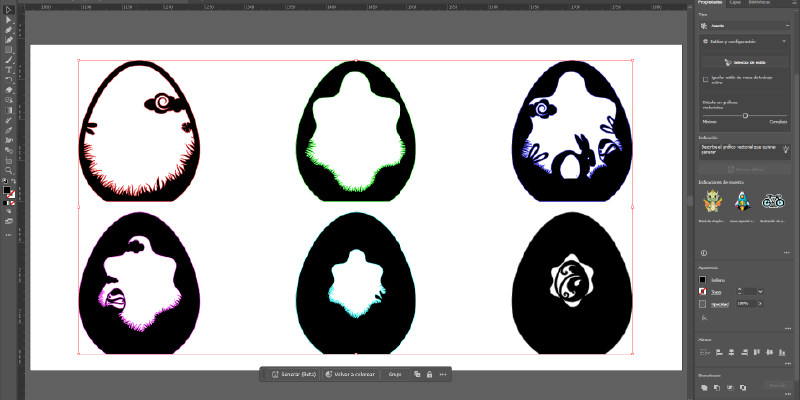Complete guide to .dxf file format: uses, advantages and tips
The .dxf file format and its uses
Meaning 'Drawing Interchange File Format' or 'drawing exchange file,' it's an image format developed by Autodesk software company, allowing data exchange between different CAD programs.
It's a vector file, meaning it doesn't store individual pixels of an image but a detailed description of its elements: lines, line widths, effects, or individual objects. It's not a pixel graphic but a vector graphic, ideal for displaying 2D and 3D drawings.
It's the preferred format for technical documentation, geometric models, technical drawings, 3D models... It's also used in creating descriptions for various modules, technical representations, detailed graphics, or product design.
Advantages of the .dxf format
- It's used without restrictions as it's open source (generally free and accessible).
- Very compatible: Very old .dxf files can be opened in modern programs, and vice versa. Old programs can open modern .dxf files.
- It allows choosing between CAD programs. Its compatibility with this software is the greatest benefit, hence its name 'Drawing Interchange File Format'.
- Being vector-based, it scales accurately without losing display quality.
- Easy exchange and high compatibility with CAD programs make it perfect for teamwork.
In practice, the most significant advantage is collaboration ease: involved individuals edit the file with their chosen CAD software, without restrictions. A key aspect, especially among different professions working consistently together.

The .dxf file in CNC manufacturing
Given all the advantages we've just discussed, the .dxf file format is essential in digital manufacturing and compatible with all NomadTech CNC machinery –including laser and plasma technology as well as milling machines–.
Being a vector file, it can be converted into G-codes: the programming language used in our numerical control machines. In other words, it turns your designs into precise instructions to guide the cutting and engraving processes on the material.
The .dxf file offers flexibility to create a wide range of products without sacrificing precision and quality, making it a bridge between creativity and the manufacturing capability of our CNC machines.
Creation, editing and conversion of the .dxf format
Within a project and team, compatibility with almost any CAD software allows opening, creating, and editing .dxf files without relying on individual operating systems.
Most programs that open and edit .dxf files also allow their conversion. In addition to various online services, Adobe Suite software –available on common operating systems– converts to .pdf format (very useful when sharing content with people not familiar with CAD software).
From Adobe Acrobat and the .dxf file, select 'Tools' and 'Create PDF file'; save the file and ready to send.
Tips for working with .dxf files
The .dxf file format is not without limitations. It generally doesn't support some new functions and features of CAD programs to make them available in other CAD software.
One of the main limitations is the lack of dimensions within the .dxf file because measurements have different notations worldwide. The size relationship in a .dxf tells how big an object is compared to another, but not the exact measurements. These must be taken separately and entered manually. Therefore, technically, there's a dimensionality issue with the .dxf file format.
It's necessary to know in which units the .dxf was originally created in the design program from which it was exported. Otherwise, when importing it into another program, it may appear with a different size. That's why, when importing .dxf files, programs usually ask In what units was it designed? Whether they’re millimetres, metres, inches, feet... In order to scale correctly.
It also doesn't support different line widths and system fonts, which must be exported and translated separately. This entails somewhat complex import processes for the recipient in subsequent file exchanges. Therefore, line thicknesses are usually encoded as line colour.
Here are some useful tips to make the most of this file type:
1. If there's too much information, clean the .dxf file and leave only the component outline. For example, technical drawings and components contain dimensions, symmetry lines, title blocks, and the like, but cannot be processed.
This occurs because the machine's program doesn't know if a line is a dimension or a line from the actual drawing. It's better to extract the clean drawing, saving time by removing dimensions and auxiliary drawings that are unnecessary for the machine's task.
2. If outlines are generated by a large number of short lines, loading time increases and cutting speed decreases.
It is recommended to use predefined shapes –circles or individual circle segments– instead of polylines.
3. Avoid overlapping and open contours as they can cause issues when converting a drawing into CNC work. Eliminate these contour overlaps and open segments –if the contour is open, you can use a line between the endpoints–.
Many CNC programs include tools for cleaning .dxf files and deleting overlapping lines. Another alternative for open contours is selecting the program to use polylines instead of loose contours, although this will depend on the program –some export cleaner and more prepared .dxf files than others–.

In conclusion, the .dxf file format enables efficient design creation and sharing, facilitating collaboration and ensuring precise and high-quality results at every stage of the process. It represents a fundamental element in digital manufacturing and its compatibility with NomadTech CNC machinery makes it indispensable in the production process.
If you would like more information about CNC technology, contact us and we’ll advise you to find the perfect CNC machine for you.


